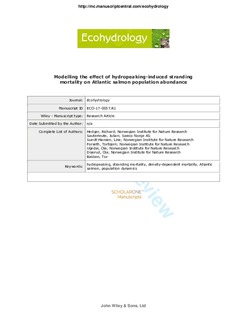Modelling the effect of hydropeaking‐induced stranding mortality on Atlantic salmon population abundance
Hedger, Richard David; Sauterleute, Julian Friedrich; Sundt-Hansen, Line Elisabeth Breivik; Forseth, Torbjørn; Ugedal, Ola; Diserud, Ola Håvard; Bakken, Tor Haakon
Journal article, Peer reviewed
Accepted version

Åpne
Permanent lenke
http://hdl.handle.net/11250/2496204Utgivelsesdato
2018Metadata
Vis full innførselSamlinger
- Publikasjoner fra CRIStin - NINA [2364]
- Scientific publications [1392]
Originalversjon
10.1002/eco.1960Sammendrag
Studies of hydropeaking‐induced stranding mortality on fish populations have been confined to analysis of empirical data and/or short‐term hydraulic‐habitat modelling of individual events and are thus limited as to how they may be used to infer long‐term effects in fish populations. In this study, the effects of stranding mortality on an Atlantic salmon population were simulated using an individual‐based Atlantic salmon population model with the objective of determining the sensitivity of population dynamics to stranding. It was found that density‐dependent mortality (an alternative source of mortality in juvenile Atlantic salmon) partially compensated for stranding mortality, acting as a negative feedback mechanism that dampened change in population abundance. Stranding caused a perturbation in population dynamics, and effects of individual stranding events persisted in time across the life stages of the population. Effects on population abundance depended on the time of year when stranding was applied, both because of intra‐annual changes in stranding mortality probability and because of intra‐annual changes in the ability of density‐dependent mortality to compensate for stranding mortality. We concluded that empirical measurements of stranding mortality have limited potential for inference of overall effects on the population, and a more dynamic modelling approach, incorporating system feedback, allows for a better modelling of the impact of stranding. Sensitivity analysis showed that population abundance was highly sensitive to density‐dependent mortality, and we suggest that this area should be prioritized for further research when investigating the effects of hydropeaking on rivers.